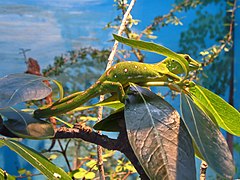| Naultinus | |||
| Gray, 1842[1] | |||
 Przedstawiciel rodzaju – N. grayii | |||
| Systematyka | |||
| Domena | |||
|---|---|---|---|
| Królestwo | |||
| Typ | |||
| Podtyp | |||
| Gromada | |||
| Rząd | |||
| Infrarząd | |||
| Rodzina | |||
| Rodzaj |
Naultinus | ||
| Typ nomenklatoryczny | |||
|
Naultinus elegans Gray, 1842 | |||
| Synonimy | |||
|
| |||
| Gatunki | |||
| |||
| Zasięg występowania | |||

| |||
Naultinus – rodzaj jaszczurek z rodziny Diplodactylidae.
Zasięg występowania
[edytuj | edytuj kod]Rodzaj obejmuje gatunki występujące endemicznie na Nowej Zelandii (Cieśnina Cooka, Wyspa Północna i Wyspa Południowa)[5][6].
Charakterystyka
[edytuj | edytuj kod]Jaszczurki z tego rodzaju prowadzą dzienny tryb życia. W ich ubarwieniu dominuje kolor zielony. Wszystkie gatunki z tego rodzaju są żyworodne.
Systematyka
[edytuj | edytuj kod]Rodzaj zdefiniował w 1842 roku angielski zoolog John Edward Gray w rozdziale poświęconym nowym taksonom jaszczurek z Nowej Zelandii w publikacji pod redakcją Graya dotyczącej różnorodności zoologicznej[1]. Gatunkiem typowym jest (późniejsze oznaczenie) zelandekon wytworny (N. elegans)[7].
Etymologia
[edytuj | edytuj kod]- Naultinus: etymologia nieznana, Gray nie podał wyjaśnienia nazwy rodzajowej[1].
- Heteropholis: gr. ἑτερος heteros ‘różny, inny’[8]; φολις pholis, φολιδος pholidos ‘rogowa łuska’[9]. Gatunek typowy (oznaczenie monotypowe): Heteropholis rudis Fischer, 1881.
- Naultinulus: rodzaj Naultinus Gray, 1842; łac. przyrostek zdrabniający -ulus[10]. Gatunek typowy (oryginalne oznaczenie): Naultinus elegans J.E. Gray, 1842.
Podział systematyczny
[edytuj | edytuj kod]Do rodzaju należą następujące gatunki[5]:
- Naultinus elegans Gray, 1842 – zelandekon wytworny[11]
- Naultinus flavirictus Hitchmough, Nielsen, Lysaght & Bauer, 2021
- Naultinus gemmeus McCann, 1955
- Naultinus grayii Bell, 1843
- Naultinus manukanus (McCann, 1955)
- Naultinus punctatus Gray, 1843
- Naultinus rudis (Fischer, 1881)
- Naultinus stellatus Hutton, 1872
- Naultinus tuberculatus (McCann, 1955)
Uwagi
[edytuj | edytuj kod]Przypisy
[edytuj | edytuj kod]- ↑ a b c J.E. Gray: Description of two hitherto unrecorded species of reptiles from New Zealand; presented to the British Museum by Dr. Dieffenbach. W: J.E. Gray: The Zoological Miscellany. To be continued occasionally. London: Treuttel, Würtz & Co., 1842, s. 72. (ang.).
- ↑ J.E. Gray: Synopsis of the contents of the British Museum. Wyd. 42. London: G. Woodfall and Son, Angel Court, Skinner Street, 1840, s. 41. (ang.).
- ↑ J.B. Fischer. Herpetologische Bemerkungen vorzugsweise über Stücke des Naturhistorischen Museums in Bremen. „Abhandlungen herausgegeben vom Naturwissenschaftlichen Verein zu Bremen”. 7, s. 235, 1882. (niem.).
- ↑ P.S. Chrapliwy, H.M. Smith & Ch. Grant. Systematic Status of the Geckonid Lizard Genera Gehyra, Peropus, Hoplodactylus and Naultinus. „Herpetologica”. 17 (1), s. 7, 1961. JSTOR: 3889712. (ang.).
- ↑ a b P. Uetz & J. Hallermann: Genus: Naultinus. The Reptile Database. [dostęp 2024-01-11]. (ang.).
- ↑ R. Midtgaard: Naultinus. RepFocus. [dostęp 2024-01-11]. (ang.).
- ↑ M.A. Smith. Remarks on some Old World Geckoes. „Records of the Zoological Survey of India”. 35 (1), s. 13, 1933. (ang.).
- ↑ Jaeger 1959 ↓, s. 118.
- ↑ Jaeger 1959 ↓, s. 194.
- ↑ Jaeger 1959 ↓, s. 275.
- ↑ Praca zbiorowa: Zwierzęta: encyklopedia ilustrowana. Warszawa: Wydawnictwo Naukowe PWN, 2005, s. 380. ISBN 83-01-14344-4.
Bibliografia
[edytuj | edytuj kod]- E.C. Jaeger: Source-book of biological names and terms. Wyd. 3 (Revised second printing). Springfield: Charles C. Thomas, 1959, s. 1–316. (ang.).









